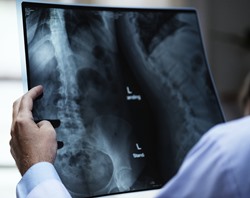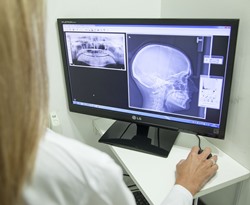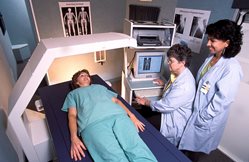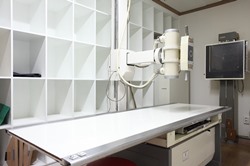How to Pick the Best X Ray Technician Course near Paul Idaho
 So you have made the decision to enroll in an X-ray tech school near Paul ID in order to become a radiology technologist. But now that you have decided to enter the rewarding field of healthcare, just how do you set about picking the ideal college and program so that you will obtain the appropriate training to become a skilled practitioner? And because the majority of states do mandate that radiology technicians become licensed, depending on where you ultimately work you might require preparation to pass a licensing test. So it’s important that you assess each of the X-ray technician schools you are considering in order to evaluate each program. A number of students begin by searching for technical schools or colleges that are within commuting distance of their homes. Next, they check tuition and usually settle on the lowest cost. But while expense and location should be taken into account, there are other important qualifications as well. For instance, you must ask if the radiology tech schools are accredited, or if they offer internship programs. These inquiries and others you should ask the X-ray Tech schools you are evaluating are provided later in this post. But first, let’s talk about what a x-ray tech does and the degrees and training choices that are available.
So you have made the decision to enroll in an X-ray tech school near Paul ID in order to become a radiology technologist. But now that you have decided to enter the rewarding field of healthcare, just how do you set about picking the ideal college and program so that you will obtain the appropriate training to become a skilled practitioner? And because the majority of states do mandate that radiology technicians become licensed, depending on where you ultimately work you might require preparation to pass a licensing test. So it’s important that you assess each of the X-ray technician schools you are considering in order to evaluate each program. A number of students begin by searching for technical schools or colleges that are within commuting distance of their homes. Next, they check tuition and usually settle on the lowest cost. But while expense and location should be taken into account, there are other important qualifications as well. For instance, you must ask if the radiology tech schools are accredited, or if they offer internship programs. These inquiries and others you should ask the X-ray Tech schools you are evaluating are provided later in this post. But first, let’s talk about what a x-ray tech does and the degrees and training choices that are available.
Radiology Tech Occupation Summary in Paul ID
 There are a number of professional designations for x-ray techs (technologists or technicians). They can also be referred to as radiologic technologists, radiologic technicians, radiographers or radiology techs. Irrespective of the name, each has the identical principal job description, which is to employ imaging machines to internally view patients for the objective of diagnosis and treatment. Some radiologic technologists may also administer radiation therapy for treating cancer. Many elect to work as generalists, while others may choose a specialization, for instance mammography. They may work in Paul ID clinics, hospitals, family practices or outpatient diagnostic imaging centers. The imaging technologies that an X-Ray tech may utilize include:
There are a number of professional designations for x-ray techs (technologists or technicians). They can also be referred to as radiologic technologists, radiologic technicians, radiographers or radiology techs. Irrespective of the name, each has the identical principal job description, which is to employ imaging machines to internally view patients for the objective of diagnosis and treatment. Some radiologic technologists may also administer radiation therapy for treating cancer. Many elect to work as generalists, while others may choose a specialization, for instance mammography. They may work in Paul ID clinics, hospitals, family practices or outpatient diagnostic imaging centers. The imaging technologies that an X-Ray tech may utilize include:
- Traditional and specialized X-Rays
- Computerized tomography (CT) or “CAT” scans
- Magnetic resonance imaging (MRI)
- Sonography or ultrasound
- Fluoroscopy
Radiographers have to care for their equipment and regularly analyze its functionality and safety. They are additionally required to keep in-depth records of all of their diagnostic procedures. As medical practitioners, they are held to a high professional standard and code of conduct.
Click Here For Free Information on X-Ray Tech Schools Near You!
Radiology Tech Degrees Offered near Paul ID
 The basic prerequisite for enrolling in an x-ray tech program is to have earned a high school diploma or GED. Radiologic technologist students have the option to earn either an Associate or a Bachelor’s Degree. An Associate Degree, which is the most common among technicians, usually requires 18 months to 2 years to finish depending on the course load and program. A Bachelor’s Degree will take longer at up to four years to complete and is more extensive in nature. The majority of students choose a degree major in Radiography, but there are other similar majors that may be acceptable as well. One thing to consider is that radiographer programs have a practical training or lab component as part of their curriculum. It may frequently be fulfilled by taking part in an internship or externship program which a large number of colleges offer through local hospitals and clinics in Paul ID or their area. Once you have graduated from one of the degree programs, you must comply with any licensing or certification requirements in Idaho or the state you will be working as applicable.
The basic prerequisite for enrolling in an x-ray tech program is to have earned a high school diploma or GED. Radiologic technologist students have the option to earn either an Associate or a Bachelor’s Degree. An Associate Degree, which is the most common among technicians, usually requires 18 months to 2 years to finish depending on the course load and program. A Bachelor’s Degree will take longer at up to four years to complete and is more extensive in nature. The majority of students choose a degree major in Radiography, but there are other similar majors that may be acceptable as well. One thing to consider is that radiographer programs have a practical training or lab component as part of their curriculum. It may frequently be fulfilled by taking part in an internship or externship program which a large number of colleges offer through local hospitals and clinics in Paul ID or their area. Once you have graduated from one of the degree programs, you must comply with any licensing or certification requirements in Idaho or the state you will be working as applicable.
Radiographer Certification and Licensing
After you have graduated from an X-Ray tech college, based on the state where you will be employed you may have to be licensed. Most states do mandate licensing, and their prerequisites vary so get in touch with your state. Currently, all states that do require licensure will recognize The American Registry of Radiologic Technologists (ARRT) certification examination for the licensing application, but many offer other options for testing as well. Several states also require certification as a component of the licensing process, otherwise it is voluntary. However, many Paul area employers prefer to hire radiology techs that have earned certification so it could enhance your career options in and around Paul ID to become certified. ARRT’s certification program requires graduation from an approved program in addition to a passing score on their comprehensive examination. ARRT also demands re-certification every 2 years, which can be satisfied with 24 credits of continuing ed, or by passing an examination.
Online X-Ray Technologist Degrees
 As a part of any degree program, x-ray tech schools will have practical or lab training included in their course of study. This is the same for online degree schools. So although you can still earn your online degree, a large amount of the training will be fulfilled either in a school lab or in an internship off-campus. Clinical training is usually performed in Paul ID family practices, medical clinics or hospitals in sponsorship with the schools. However the online section of the training can be accessed in the privacy of your Paul residence. Students who keep working while earning their degree typically discover that the online style of learning is much more practical with their active schedules. Plus online colleges are generally more affordable than on-campus options. Along with reduced tuition, expenditures for commuting and study materials may be reduced also. But just make sure that the online school you enroll in is accredited (more on the benefits of accreditation later). So if you are dedicated enough to learn with this less formalized style of training, then an online school may be the right option for you.
As a part of any degree program, x-ray tech schools will have practical or lab training included in their course of study. This is the same for online degree schools. So although you can still earn your online degree, a large amount of the training will be fulfilled either in a school lab or in an internship off-campus. Clinical training is usually performed in Paul ID family practices, medical clinics or hospitals in sponsorship with the schools. However the online section of the training can be accessed in the privacy of your Paul residence. Students who keep working while earning their degree typically discover that the online style of learning is much more practical with their active schedules. Plus online colleges are generally more affordable than on-campus options. Along with reduced tuition, expenditures for commuting and study materials may be reduced also. But just make sure that the online school you enroll in is accredited (more on the benefits of accreditation later). So if you are dedicated enough to learn with this less formalized style of training, then an online school may be the right option for you.
Subjects to Ask X Ray Tech Schools
Once you have chosen the type of degree that you would like to earn, you can initiate the process of searching for and evaluating x-ray technician colleges near Paul ID. You will also need to decide if you prefer to attend online classes or commute to a nearby campus. If you choose the latter, then obviously the location of the college will be critical. The cost of tuition and ancillary expenses will be a material variable as well. But in addition to location and cost, what more should you factor in when evaluating colleges? Well, you should ask if the colleges are accredited, and if they provide externship or internship programs. To help you learn some of these essential details before you make your selection, we have compiled a list of questions that you need to ask the schools you are looking at.
Are the Radiology Tech Colleges Accredited? Most xray tech colleges have earned some type of accreditation, whether regional or national. Nevertheless, it’s still imperative to confirm that the program and school are accredited. Among the most highly respected accrediting organizations in the field of radiology is the Joint Review Committee on Education in Radiologic Technology (JRCERT). Programs earning accreditation from the JRCERT have gone through a rigorous assessment of their teachers and course materials. If the program is online it can also obtain accreditation from the Distance Education and Training Council, which targets online or distance education. All accrediting agencies should be recognized by the U.S. Department of Education or the Council on Higher Education Accreditation. Along with ensuring a quality education, accreditation will also assist in obtaining financial assistance and student loans, which are frequently not available for non-accredited schools. Accreditation might also be a pre-requisite for certification and licensing as required. And a number of Paul ID health facilities will only hire a graduate of an accredited school for entry-level openings.
Are Internships Offered? Ask if the radiology technician schools you are assessing have associations with area hospitals or clinics for internship programs. Not only are internships a terrific means to obtain practical experience in a clinical environment, they are additionally a means to satisfy the clinical training requirement for most programs. As a secondary benefit, they can assist graduates and students develop professional connections in the Paul ID healthcare community and help with job placement.
Is Job Placement Help available? You will probably want to hit the ground running after graduating, but finding that initial job in Paul ID in a new profession can be challenging without help. Find out if the x-ray tech schools you are reviewing have job assistance programs and what their success rates are. High and rapid placement rates are a good indication that the schools have large networks and good relationships with Idaho healthcare employers. It also corroborates that their graduates are highly regarded and sought after.
Where is the College Located? For a number of students, the college they decide on will have to be within commuting distance of their Paul ID home. Individuals who have chosen to attend classes online naturally will not have to worry themselves with the location of the campus. However, the availability of local internships will be of importance. Something to bear in mind is that if you decide to enroll in a school that is out of state or perhaps out of your local area, you may need to pay a higher tuition. State colleges typically charge higher tuitions for out of state residents. And community colleges typically charge a higher tuition to those students that live outside of their districts.
What are the Class Sizes ? Unless you are the sort of student that prefers to sit far in the rear of the classroom or get lost in the crowd, you will probably want a smaller class size. Small classes allow for more individual participation and personalized instruction. Ask the Paul ID colleges you are considering what the typical student to teacher ratio is for their classes. If practical you may prefer to monitor one or more classes before making your final determination. This will also give you an opportunity to talk with a few of the students and instructors to get their perspectives regarding the xray tech program as well.
Does the School Accommodate your Schedule? And finally you must verify that the xray tech program you ultimately pick can offer the class schedule you need. This is particularly important if you choose to continue working while attending school. If you need to schedule night or weekend classes in the Paul ID area, make sure that they are available. If you can only enroll on a part-time basis, check if that is an option and how many courses or credit hours you would have to enroll in. Also, learn what the procedure is for making up any classes that you may miss as a result of illness, work or family obligations.
Top Part Time Radiology Tech Programs Paul ID
 Choosing the best x-ray technician school is a crucial first step toward initiating a rewarding new career providing diagnostic medical services to patients. The ideal radiologic technologist must be in good physical shape. X-Ray techs typically stand for the majority of the day and position and in some cases lift the patient to get the correct image. Prospects must also demonstrate a capability to pay strict attention to detail and to comply with the safety requirements developed to protect both the patient and the medical team. X-Ray techs work very closely with patients, other technicians as well as the doctors and radiologists. Having social skills is a must in order to have a good work environment and deliver the best available patient care. You originally came to this website due to an interest in Top Part Time Radiology Tech Programs and wanting more information on the topic Compare Accredited Radiologic Tech Schools. However, as has been discussed in this article, there are several questions that you should ask each college you are considering prior to making your ultimate decision. This is equally true whether you enroll in an online school or drive to classes on campus. By asking the right questions you can analyze and compare each school so you can narrow down your choices before making your final choice. And with the appropriate education and your dedication to be successful, you can accomplish your goal to practice as a X-ray tech in Paul ID.
Choosing the best x-ray technician school is a crucial first step toward initiating a rewarding new career providing diagnostic medical services to patients. The ideal radiologic technologist must be in good physical shape. X-Ray techs typically stand for the majority of the day and position and in some cases lift the patient to get the correct image. Prospects must also demonstrate a capability to pay strict attention to detail and to comply with the safety requirements developed to protect both the patient and the medical team. X-Ray techs work very closely with patients, other technicians as well as the doctors and radiologists. Having social skills is a must in order to have a good work environment and deliver the best available patient care. You originally came to this website due to an interest in Top Part Time Radiology Tech Programs and wanting more information on the topic Compare Accredited Radiologic Tech Schools. However, as has been discussed in this article, there are several questions that you should ask each college you are considering prior to making your ultimate decision. This is equally true whether you enroll in an online school or drive to classes on campus. By asking the right questions you can analyze and compare each school so you can narrow down your choices before making your final choice. And with the appropriate education and your dedication to be successful, you can accomplish your goal to practice as a X-ray tech in Paul ID.
Other Idaho Diagnostic Locations
Paul, Idaho
Paul is a city in Minidoka County, Idaho, United States founded in 1907. The population was 1,169 at the 2010 census. It is part of the Burley, Idaho Micropolitan Statistical Area. The town received its name from Charles H. Paul, an engineer on the Minidoka Reclamation Project.
Paul is located at 42°36′23″N 113°47′0″W / 42.60639°N 113.78333°W / 42.60639; -113.78333 (42.606349, -113.783235),[4] at 4,150 feet (1,260 m) in elevation. It lies within the Magic Valley region of the Snake River Plain.
As of the census[2] of 2010, there were 1,169 people, 446 households, and 311 families residing in the city. The population density was 1,826.6 inhabitants per square mile (705.3/km2). There were 473 housing units at an average density of 739.1 per square mile (285.4/km2). The racial makeup of the city was 76.6% White, 0.9% Native American, 0.8% Asian, 18.0% from other races, and 3.6% from two or more races. Hispanic or Latino of any race were 28.5% of the population.
